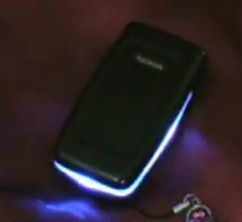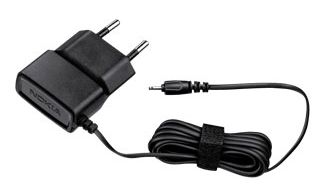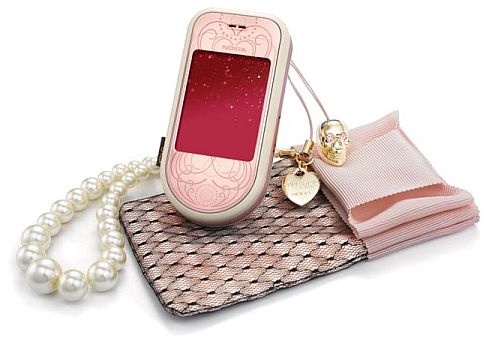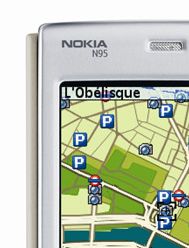Ten Problems with Phones that No One Ever Talks About
 1. How do you find phones in a bag?
1. How do you find phones in a bag?
If you've ever regularly carried your phone in a bag with lots of other things, you'll know it's quite hard to find sometimes. If the screen is pressed right up against something, with none of its light visible, it can be very tricky indeed to get to your phone before it stops ringing.
What would be nice is a phone model where the light is visible from many sides of the phone, but these seem to be rarer than igloos in Australia. A couple of models, the Nokia 2650 and 3220, would light up on three sides of the phone when receiving a call, but both of them date from 2004 and have since been discontinued. Where are the easy-to-find phones now?
2. Why do we have manufacturer-specific chargers?
It's a very strange thing, but it seems that if you want to charge a phone you usually have to use a charger made by the phone manufacturer. Why? It can't be to do with device specifications, because the standard Nokia charger works on all their new models from a cheap low-power basic phone right up to a battery-hungry smartphone or even a large-screen internet tablet. Surely if such radically different devices can use the same charger, all phone manufacturers should be able to come up with a single common standard?
This isn't a naive suggestion, phone manufacturers already have common standards for all kinds of other add-ons such as SD memory cards, headsets, keyboards, GPS units etc. Why shouldn't chargers be added to that list?
It's not like manufacturers make that much money selling their own separate chargers, each phone already comes with a charger so very few people want to buy one separately.

 3. How do you stop a phone getting covered in face muck?
3. How do you stop a phone getting covered in face muck?
After the original N-Gage got a disastrous reception, partly because of its "side talking", Nokia rushed out an updated model called the N-Gage QD with "normal talking", i.e. you held it flat against your face like any other phone instead of holding it sideways. Ironically enough, one of the reviewers of the QD complained that all the grease from his face stuck to the screen, and he preferred the sideways model. He has a point.
If you're in the middle of a hot summer you'll probably want to use suntan lotion, but that means that whenever you use your phone it will get covered in the stuff. It's especially bad if it has a black casing.
Perhaps (once they're brave enough to defy the inevitable N-Gage comparisons) a phone manufacturer might include an extra sidetalking mode on one of their models for people who don't want to cover their €500 device in sunblock.
4. Why can't all phones be turned into granny phones?
In case the term isn't familiar to you, "granny phones" are mobile phones intended to be easy enough for practically anyone to use. With the increasing complexity of phones, even cheap models, the need for granny phones is greater than ever, yet it's almost impossible to find such devices.
An older relative of mine needed a new mobile phone, so I recommended buying the most basic model they could find in order to avoid unneccessary complexity. Alas, it seems that all phones now have a minimum of ten menu icons, and often use symbols instead of words so that anyone not familiar with high technology is confronted with the 21st Century's equivalent of hieroglyphics.
There was a news story recently about Tony Blair recently sending his first text message. Now, that could well just be a publicity stunt to keep him in the public eye, but the important point is that it might not be. It's totally plausible that a fairly intelligent person in non-technical fields could be completely baffled by the interfaces used in high technology.
The problem seems to stem from the mobile world being dominated by the philosophy that all mobiles have to be far more than just phones. Yet a lot of non-technical people would love to have a mobile which IS just a phone. If there was a mobile with just a numerical keypad, green call button and red hang up button, that would make mobile telephony so much easier for technophobes.
But the part that's really annoying is that a simpler interface should be possible with all existing phones. There's no reason why a phone should force you to use a complex menu system if all you want to do is make a call. All phones ought to have a "granny phone" mode, perhaps through the profiles system. All you would see on the screen is the contacts list, and calling someone would be just a case of picking up the phone and selecting the name you want, with no other options available. Entering names into the contacts might be tricky, but that could be done by a relative on the user's behalf when they first buy the phone, and once the contacts section is populated the phone would be stunningly easy to use.
5. Why can't we have fashion smartphones?
One of the tragic things about smartphones is that they seem to still be treated as something separate from fashion phones. If you want a phone to look interesting and different, you're forced to forget about any kind of smart features. It's a sort of Hollywood-style "babes and nerds" mentality, that beauty and intelligence can never overlap.
In the past the excuses given were that smartphones were too complex and unstable for the kind of casual user that purchases fashion phones, but the latest S60 and Series 40 models are functionally very, very similar. The latest S60 phones are far more stable, fast and easy to use than older models, while the latest version of Series 40 now looks and feels extremely similar to S60.
Please, please, someone give us a smartphone that looks striking, glitzy and non-techie. Just for once.

It's got the looks, but not the brains.
6. Why are SIM cards linked to particular networks?
You've probably heard of SIM-free phones. Well, how about network-free SIM cards?
The SIM card was invented as a way of identifying subscribers to a phone network, and indeed the name stands for Subscriber Identity Module. It's essentially just an electronic ID card which gives you permission to use a particular phone network (and certain other phone networks through roaming).
But why should it be restricted to one network like this? Is your credit card restricted to one shop? SIM cards ought to be simply a way of proving who you are and where the phone bill should be sent, just like credit cards. There's no reason why simply proving your identity requires you to be tied to one network, and you shouldn't have to swap SIM cards just to switch networks. SIM cards ought to be linked to a payment system, not a service provider.
In Finland and many other countries, if you want to phone abroad you do so simply by dialling a particular network's foreign number prefix (for example 991 is Saunalahti's prefix) and then the foreign number. The prefix determines which network charges you for the call, and you can use any prefix you want at any time regardless of which network your SIM card is on. There's no registration, no separate payment, you simply use the prefix of the network that you think offers the best rates and it appears on your normal phone bill. If it's that simple for foreign calls, why shouldn't it be that simple for domestic calls? Why can't we pick the network we use just by choosing a prefix?
When you go shopping, you might go to one supermarket or you might go to another, based on the price and quality of their products. There's absolutely nothing to stop you using both, or switching from one to the other whenever you want. This should be true of phone calls as well, you should be able to switch to any network's services at any time. This is already the situation on wi-fi devices, where you can use any commercial wi-fi hotspot at any time, as long as you prove your identity.
Removing the networks' involvement in SIM cards would bring about huge levels of competition, networks would constantly adjust and advertise their prices as much as possible, just like supermarkets do, and indeed this is what foreign call services do in Finland. Phone networks would be forced to be extremely competitive, and calls would become cheaper and higher quality.
7. Why is it still so difficult to install phone software?
The game Snakes was made by Nokia as a free giveaway for all owners of N-Gage and N-Gage QD smartphones. It was a completely free download, you were allowed (indeed encouraged) to give it away to friends, and you could even send it from one N-Gage to another over Bluetooth. Nokia was doing everything it could to get this game into people's hands.
But... the N-Gage support board had posts from many people who just couldn't do it. They couldn't cope with saving a file to their PC, then transferring it to a memory card, then running the S60 installation application. Now, if they couldn't cope with that when the game's publisher was trying to help them do it, these people are also never going to be able to install pirated software either. In other words, these are the people who would be most likely to buy commercial phone software instead of stealing it.
You would think that people with an interest in the S60 or UIQ commercial application ecosystem would go out of their way to provide purchase methods easy enough for this target audience to use, but the legal method for buying smartphone apps is still mainly to download to a PC, then transfer and install. And it seems very unlikely these kinds of people could cope with things like IMEI numbers.
Of course Nokia has, in theory, started providing such a service with its Download! icons on newer S60 models, but that brings me onto point 8...
8. Why isn't the Download! service on sim-free S60 phones packed with software on all models?
Phone Network Operators are infamous for altering and in some cases crippling smartphone functionality, so it wouldn't be surprising if they held tight control over all applications bought and sold through one of their sim-locked phones.
But what about those of us who buy sim-free phones? Surely we are free from network interference in how we use these devices? If that's the case, why on earth is Nokia's Download! service so empty on so many sim-free models?
The S60 3rd Edition software section of this site lists almost 300 different applications and games available. Why then does Nokia Download! only have perhaps half a dozen or a dozen apps and games? Even the apps and games listed are slightly deceptive, many of them are Java rather than S60 applications.
There's so much good stuff out there in the S60 application world, but it's not really getting any exposure in official download channels. It would benefit Nokia greatly if its S60 models had an ever-expanding library of apps and games through Download!, and it would benefit S60 developers if they had access to this direct channel through to S60 users, but for some reason this channel is left mostly unused.
 9. Why isn't the model number written on non-Nseries phone casings?
9. Why isn't the model number written on non-Nseries phone casings?
Perhaps 100% of the people reading this know the model number of their phone off by heart, and could probably recognise other models just by seeing their photographs. However, for most people these rather anonymous model numbers mean very little, and when it comes to identifying their phone for compatibility purposes a lot of people run into trouble.
Yes, the model number is usually written on a plate under the battery, but that's a lot of bother to go to if you're in the middle of a shop looking for suitable accessories. It would help both practically and in promotional terms if phones (especially basic ones) had their model number written somewhere on the outside. It hasn't harmed Nseries sales to take this approach, so why not extend it to non-Nseries phones too?
10. Whatever happened to chunky batteries?
In the old days, when batteries generally clipped onto the back of mobile phones rather than residing within them, you had the option of buying a normal slimline battery (which had a short lifetime but made the phone smaller and lighter) or you could go for a larger chunky battery (which stuck out at the back but had a much longer battery life).
As most users of smartphones know only too well, the one feature that no one seems to be improving is the battery life. Most smartphones die in less than a day if you use their functions fully, which brings into question the point of having those functions in the first place. Many smartphone users would greatly enjoy the option of a much bigger battery, even if it means making the phone itself look more bulky.
Clearly some phone designs just don't have room for bigger batteries, but many do, if a bigger battery cover is supplied with the bigger battery. The N93 for example would benefit from a bigger battery as it would allow much longer videos to be shot with its DVD-quality camera. Its battery cover is a thin, entirely external object which could easily be replaced by the user with another cover that had room for a larger battery. There would be a bump visible on the back of the phone, but this is a price many may be glad to pay if it means they can shoot more video. Indeed, dedicated camcorders usually do take this approach, with a small battery included but room for larger batteries if an enthusiast wants to install one.
Obviously for promotional purposes and sales in the mainstream market, slimmer smartphones are the only way to go. However, it would be nice if hardcore smartphone owners who heavily use these amazing features were allowed to provide them with a much beefier power source. There ought to be some kind of battery upgrade pack, that had a bigger battery and cover to accommodate it, at least for those models such as the N93 where installation would be easy.
Krisse, AllAboutSymbian, 15 July 2007


